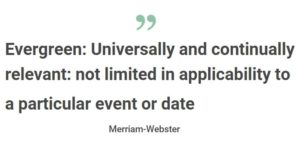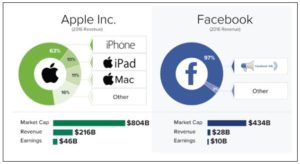Image Source
It may be tempting to create buzz-worthy, trendy content to catch the attention of fickle consumers, but content that’s written to capitalize on passing fads quickly loses its value and relevance.
In this post, we’ll review how to create evergreen content (content that has perennial value) which will boost your SEO efforts and draw people to your website again and again.
Why is evergreen content important?
Creating high-quality evergreen content is an excellent way to demonstrate your expertise on a given topic and it very rarely (if ever) needs to be updated.
Timeless, useful information is content that people want to link to and share, making it a great way for customers to find your business. Evergreen content – which is naturally keyword rich and relevant – is also beneficial for organic search rankings. Google ranks web pages based on relevancy (among other things) and this includes time spent on your website. Thus a well-written piece of content that keeps people reading (or watching) will signal to Google and other search engines that your content to a user’s search query.
What is evergreen content?
In the context of your digital strategy, evergreen content is enduring.
It’s content that people keep searching for again and again. It’s shared widely. It shirks all trends and temporary whims and will continue to draw people to your website, company or social media profile today, tomorrow, and five years from now.
Seasonal vs. evergreen content
While we can simply say that evergreen content is content that doesn’t meet any of the above criteria, it’s helpful to have some examples of what it’s not.
- Anything tied to current events or trends – Politics, celebrity memes, the hottest toys – all of these are examples of topics that flame into the public’s interest then rapidly fade into obscurity.
- Holiday and seasonal topics – Holidays and seasons come and go and while content focused on these themes might be considered evergreen (e.g., how to trim a Christmas tree), it’s only relevant for a brief couple of months during the year. Evergreen content is always relevant.
- Articles about anything that changes rapidly – Software, fashion, current events, entertainment and just about anything that will be less relevant a year from now as it is today is not considered evergreen.
Here is an example of a video we created for our client, Harney & Sons, a boutique manufacturer of fine teas. This video is seasonal which instantly disqualifies it as evergreen content, but it is still content that endures throughout the holidays.
At about one minute long, this video has over 8000 You Tube views and over 1 million views on Facebook, proving that good content is valuable for your brand even if it isn’t technically evergreen. This video can be reused each season too (if the client wants) or the theme can be expanded on with new content each year building on the success of the older videos.
The client has a new video this year which – after less than 3 weeks – has received over 407,000 views on Facebook and over 2000 on YouTube.
Creating timelessness through evergreen content
If your focus is on creating valuable, original content then you’re already well on your way to being evergreen.
But, there is some amount of luck involved in creating truly timeless pieces that stand out from the clutter. The truth is that you can’t always know what’s going to resonate with people in an enduring way. Some topics are so saturated, that it can be impossible to create something that shows up at the top of the search results or that people want to share.
In the interest of not recreating the wheel, try to avoid themes and topics which are repeated again and again.
Here are a few examples from our industry:
- A search for “what is digital media” on Google returns 5,620,000,000 results
- “mobile marketing” returns 2,500,000,000 results
- “web design best practices” returns 636,000,000 results
It’s not enough to create content around a timeless topic that has broad appeal, you also need to be original and somewhat specific.
An example of this from our blog is a post titled, What is the difference between CMYK and RGB colors?
This post, written in 2014, continues to show up in the top of Google’s organic search results and drive traffic to our blog over 4 years after we originally posted it.
The post is under 800 words, proving that length isn’t important if your content is evergreen. Rather, the key is to create something unique which draws from your expertise and provides real value to your readers, viewers, and customers.
Some more examples of evergreen content
Broadly, here are some examples of themes that lend themselves well to being evergreen:
- Definitions of industry terms or concepts
- Instructional content, particularly videos
- In-depth articles or analyses from an expert perspective
- Universal truths (generally more consumer-based content such as essays about parenting, grief, marriage, etc.)
- Expert advice, tips or lists unrelated to trends (e.g., the top 10 mistakes businesses make when creating a logo)
The above examples are generic, but evergreen content needs to endure and stand out. There are few different ways you can achieve this in your content
- Use video – Evergreen content is supremely sharable. A great way to motivate sharing is to make useful (and unique) instructional, funny or informative videos.
Here is an example of a video we created for the City of Poughkeepsie
This video is evergreen because it conveys information that’s useful in an ongoing way. While the video has less than 200 views (as of December 2018), this will change as people search for information contained in the video (namely, preserving their ash trees from an invasive pest).
- Create your own graphics – Nothing’s more shareable than a great image, illustration or infographic. The trick is to create something that communicates important information in a visually compelling way. It can be complex or simple, but it must be useful.
Here’s an example of an infographic that demonstrates how tech giants make their money.
Image Source: Visual Capitalist
- Use examples from your own work – Listing (or showing) specific examples from your own experience is a particularly compelling way to create evergreen content.
This lets your audience peek behind the curtain to see how “someone else” is doing something. Here is an example of how we did this in one of our recent blog posts about rebranding and redesigning a client’s website[JD1] . We created this post using a case-study format and illustrated it with actual before/after images from the redesign.
- Use unique language when you describe a common theme – Evergreen content should strike a balance between using known, familiar language and introducing readers to unique or technical language that may be very specific.
The CMYK vs. RGB post I referenced above is a great example of this. The post defines both acronyms and goes on to explain (using illustrated examples) the difference between the two.
We could have titled this post “Understanding the use of color in web and print formats” or something equally generic, but we got right to the heart of a very common question many of our clients have.
It turns out that many people have this question (reason #1 that the content is evergreen). The unique and specific title has also the post rise to the top of the search results (reason #2 that the content is evergreen).
Conclusion
While it can be difficult to predict if your content will endure, you’ll be in a better position to create evergreen content if you follow some of the guidelines we outlined in this post.
Here’s a handy checklist to send you on your way.
Evergreen Content Checklist
- It endures over time
- It’s not tied to a season, holiday or event
- It’s shareable
- It’s unique but has broad appeal
- It uses specific examples drawn from your expertise
- It contains unique images/videos/graphics
Happy creating!



